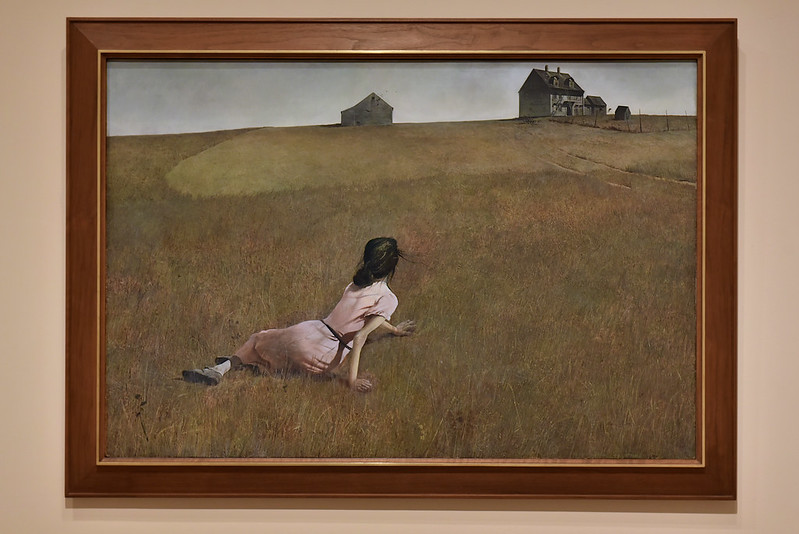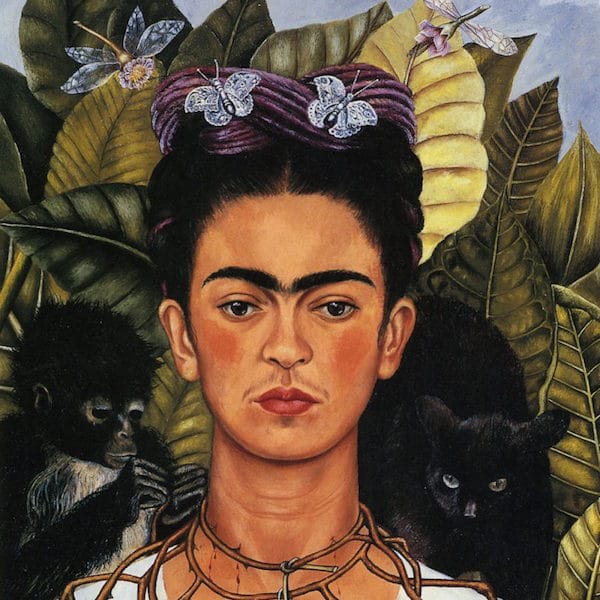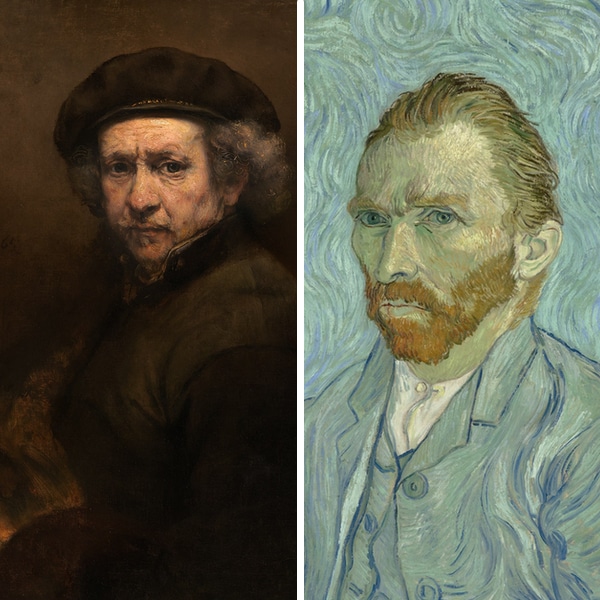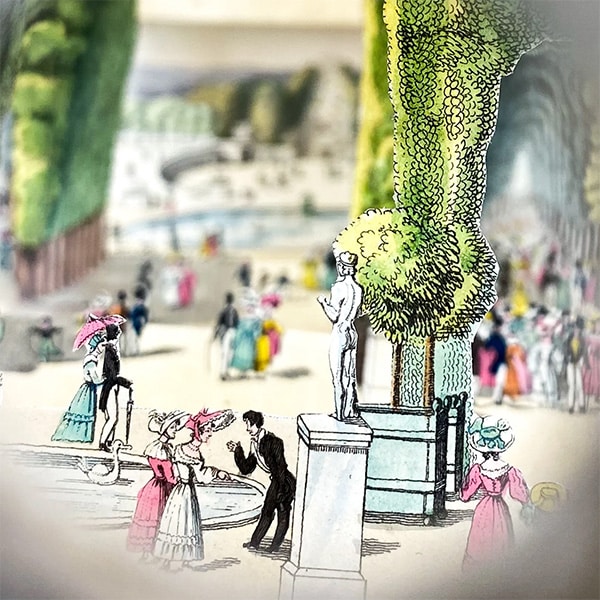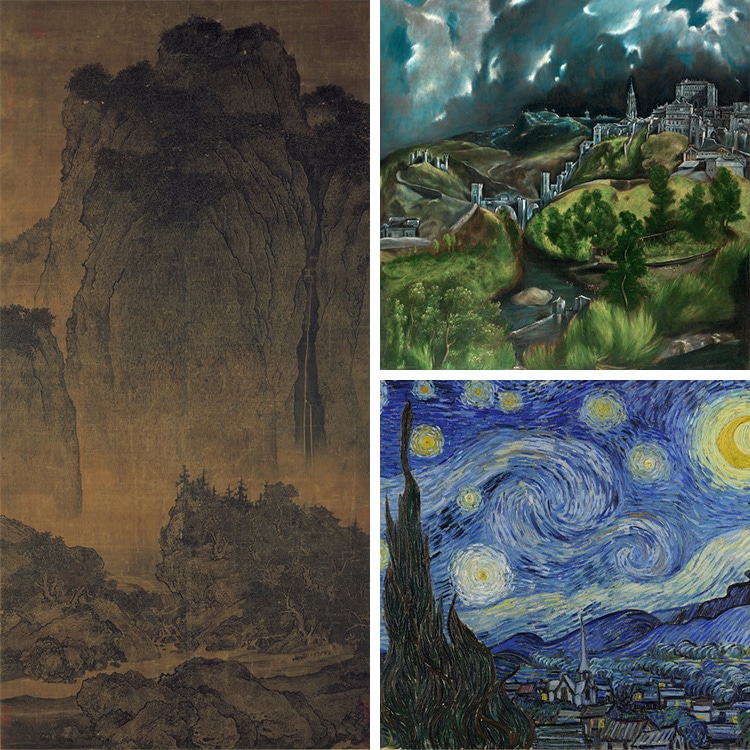
Artists have expressed deep connections to nature throughout history. This interest in the natural world is best exemplified in the genre of landscape painting, which focuses on natural settings like mountains, forests, and rivers as subject matter. The most famous landscape paintings encompass works from China, Europe, and beyond that have left a lasting influence on the course of art history.
Some of these depictions have made their inspirations immortal, such as in the case of Vincent van Gogh's The Starry Night, which takes place near the French town of Saint-Rémy-de-Provence. Others, like John Constable's The Hay Wain, feature realistic ways of capturing nature and helped to develop a style.
Scroll down to learn about 18 famous landscape paintings from art history.
Discover 18 famous landscape paintings.
Fan Kuan, Travelers Among Mountains and Streams, Northern Song dynasty, c. 1000
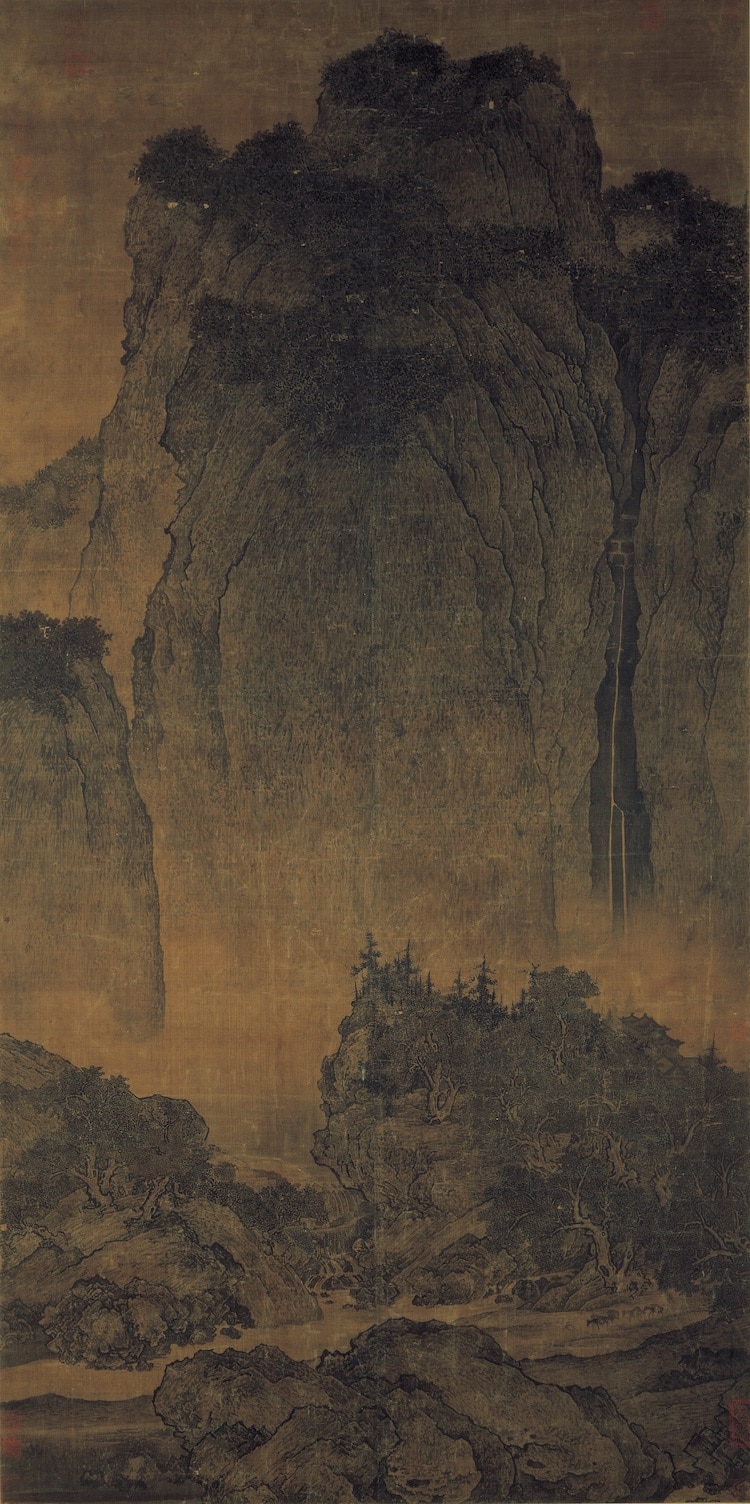
Fan Kuan, “Travelers Among Mountains and Streams,” c. 1000 (Photo: National Palace Museum via Wikimedia Commons, Public domain)
Created on a seven-foot-long hanging scroll, Fan Kuan's work Travelers Among Mountains and Streams is one of the most influential examples of early Chinese landscape painting and representative of the Northern Song school. It features a three-plan perspective of near, middle, and far that is typical of art from this time. Although there are human figures in the composition, they are dominated by grandiose nature.
Gio Xi, Early Spring, signed and dated 1072
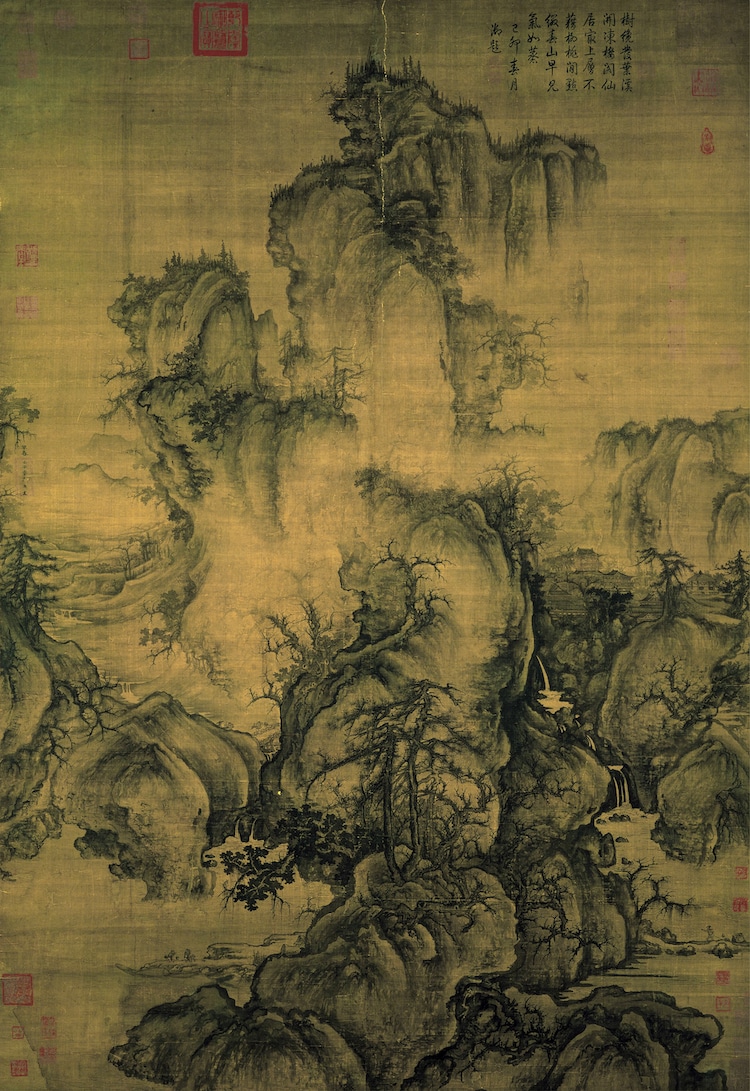
Guo Xi, “Early Spring,” 1072 (Photo: National Palace Museum via Wikimedia Commons, Public domain)
Originally from the Henan province, Chinese artist Guo Xi was another influential landscape painter. Early Spring is one of his most renowned paintings, which exhibits the artist's aptitude for incorporating multiple perspectives within one composition.
Giorgione, The Tempest, c. 1505
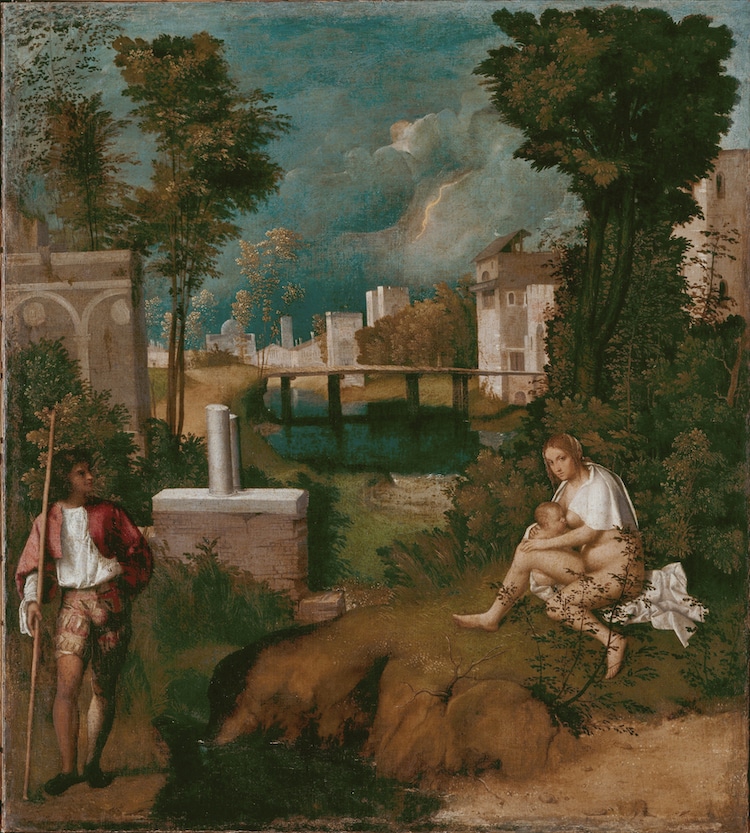
Giorgione, “The Tempest,” c. 1505 (Photo: Wikimedia Commons, Public domain)
Giorgione was one of the pioneering artists of the Venetian School of painting and The Tempest remains one of his most beloved and ambiguous works of art. In the right foreground, it features an anonymous woman breastfeeding her baby and a soldier carrying a long staff standing on the left. Here, the verdant landscape is not merely decorative, but a prominent part of the composition. Due to this, The Tempest is considered influential in the development of landscapes and one of the most famous Renaissance paintings.
Pieter Bruegel the Elder, The Hunters in the Snow, 1565
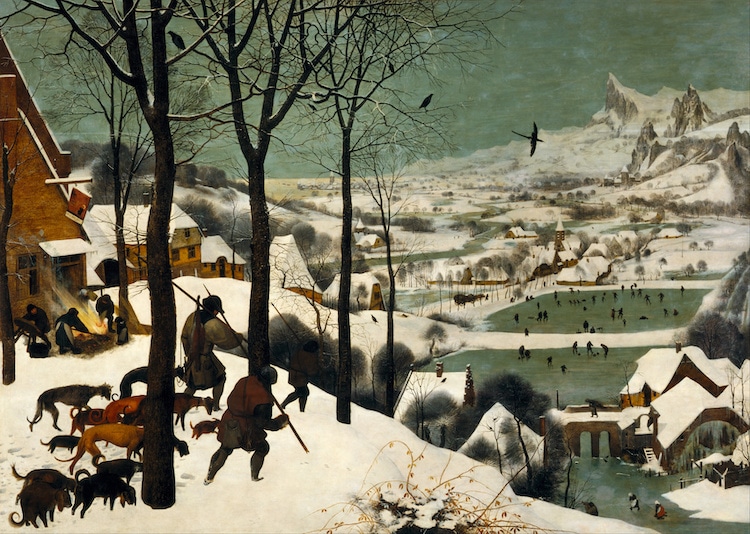
Pieter Bruegel the Elder, “The Hunters in the Snow,” 1565 (Photo: Kunsthistorisches Museum via Wikimedia Commons, Public domain)
Pieter Bruegel the Elder was one of the leading artists of the Northern Renaissance. His painting The Hunters in the Snow was part of a series dedicated to portraying different times of the year. This work depicted a scene in the winter, in which a pair of hunters lead their dogs through the snowy landscape. While the figures are tucked into the left-hand corner of the painting, the rest of the canvas is dedicated to the view of the faraway village and frozen lakes.
Annibale Carracci, Fishing, before 1596
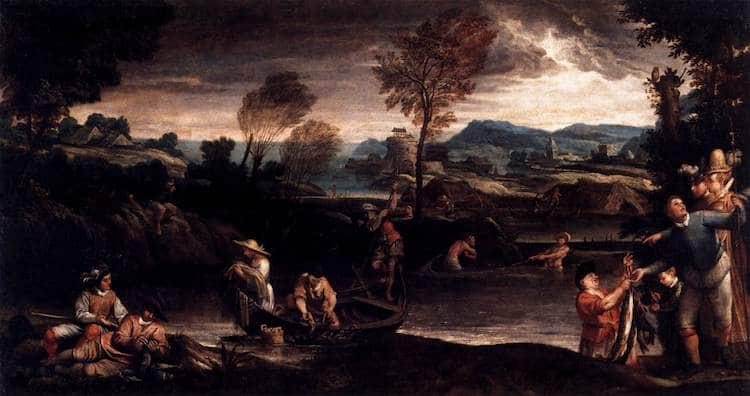
Annibale Carracci, “Fishing,” 1585–1588 (Photo: Louvre via Wikimedia Commons, Public domain)
Baroque artist Annibale Carracci was a well-rounded Italian painter who is often compared to his rebellious contemporary, Caravaggio. The large landscape Fishing, which was meant to be displayed with another piece entitled Hunting, was given as gifts to the king of France by Carracci's patron Camillo Pamphili. These works display a deep interest in landscape painting, exploring some of the ways the artist can divide the space to create narratives.
El Greco, View of Toledo, c. 1596–1600
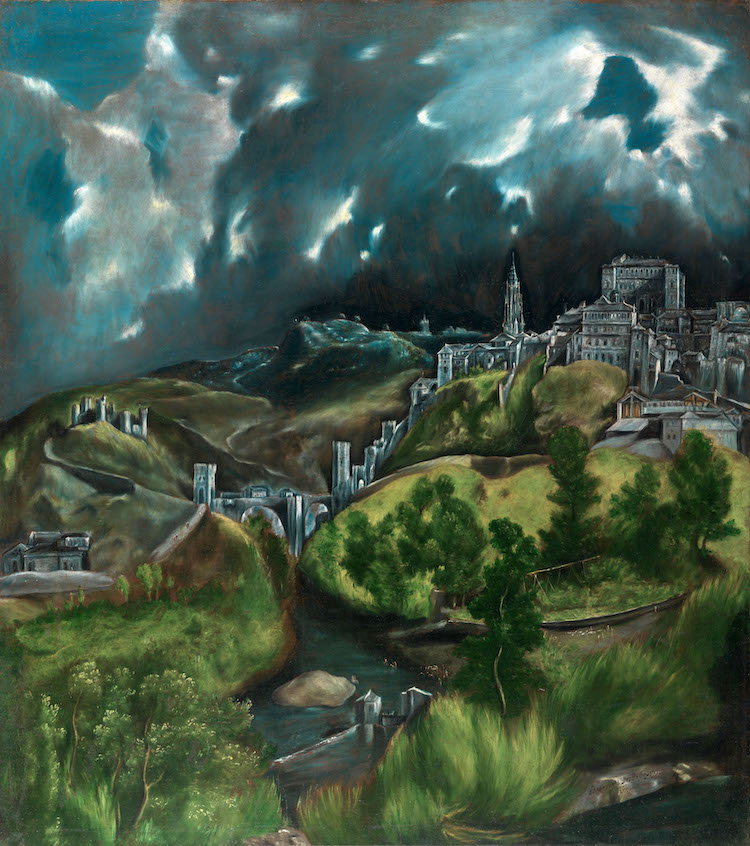
El Greco, “View of Toledo,” c. 1596–1600 (Photo: The Met via Wikimedia Commons, Public domain)
Grounded between the Late Renaissance and the emerging Mannerist art movement is the coveted work of El Greco. His uniquely radical style left a lasting impact on the course of art history. Most notably among his oeuvre is his painting View of Toledo, which is one of two surviving landscapes by the Greek artist. It features a striking blue-black sky that appears to be on the verge of a storm. It is referred to as one of the most famous depictions of the sky.
Claude Lorrain, Pastoral Landscape, c. 1639
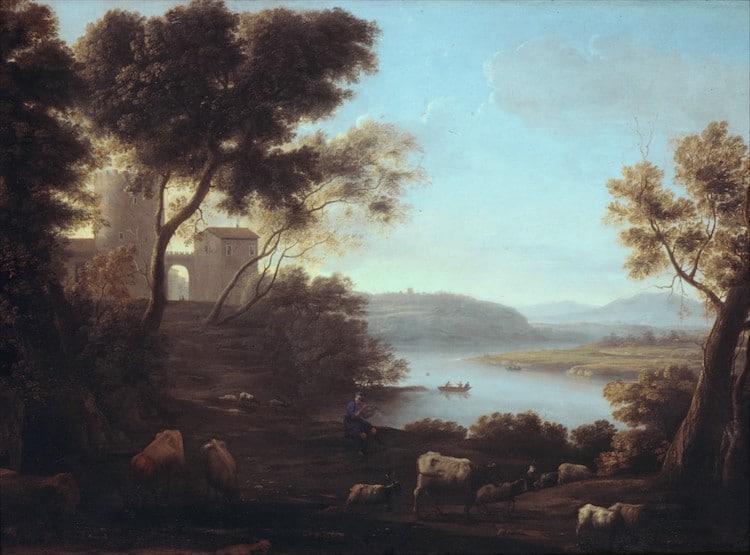
Claude Lorrain, “Pastoral Landscape: The Roman Campagna,” c. 1639 (Photo: The Met via Wikimedia Commons, Public domain)
Baroque painter Claude Lorrain is known for his idyllic portrayals of allegorical scenes rooted in either the Bible or in classical mythology. Pastoral Landscape is a work that aptly conveys this interest, featuring a soft-focused portrayal of the countryside with livestock, a shepherd, and classical architecture on the distant horizon.
Nicolas Poussin, Spring (The Earthly Paradise), 1660–1664
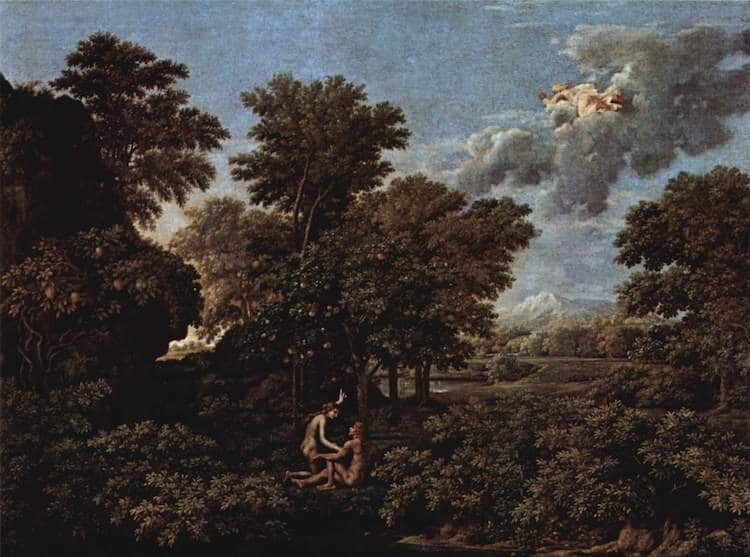
Nicolas Poussin, “The Spring,” 1660–1664 (Photo: Louvre via Wikimedia Commons, Public domain)
Working from Rome, French-born painter Nicolas Poussin created exquisite paintings typical of the classical Baroque style. The Spring is part of a series depicting the four seasons and features a lush wooded landscape, in which Adam and Eve are sitting on the grass.
Giovanni Antonio Canal (Canaletto), The Grand Canal at the Church of La Salute, c. 1738–1742
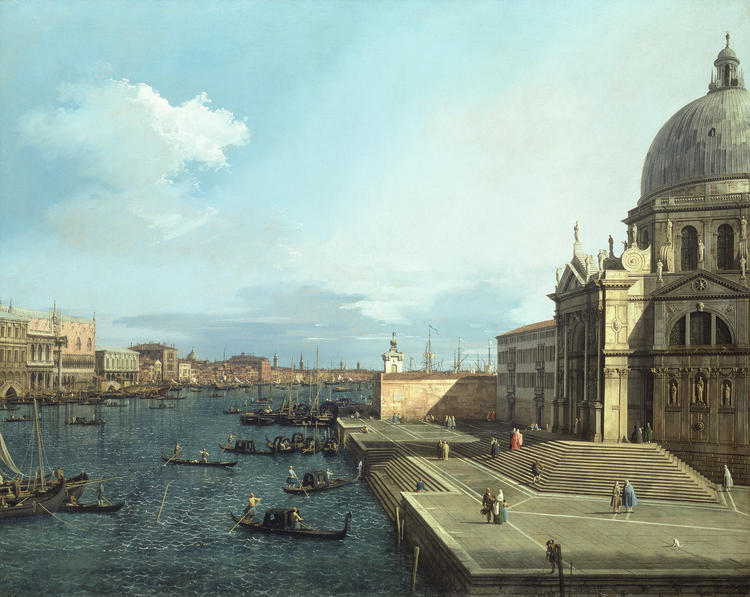
Canaletto, “The Grand Canal and Santa Maria della Salute,” 1738–1742 (Photo: Wikimedia Commons, Public domain)
18th-century Italian artist Giovanni Antonio Canal, better known as Canaletto, was known for his city views of major cities, including Venice, Rome, and London. The Grand Canal and Santa Maria of La Salute is emblematic of his body of work, depicting a detailed panorama of Venice.
Caspar David Friedrich, Wanderer Above the Sea of Fog, c. 1817
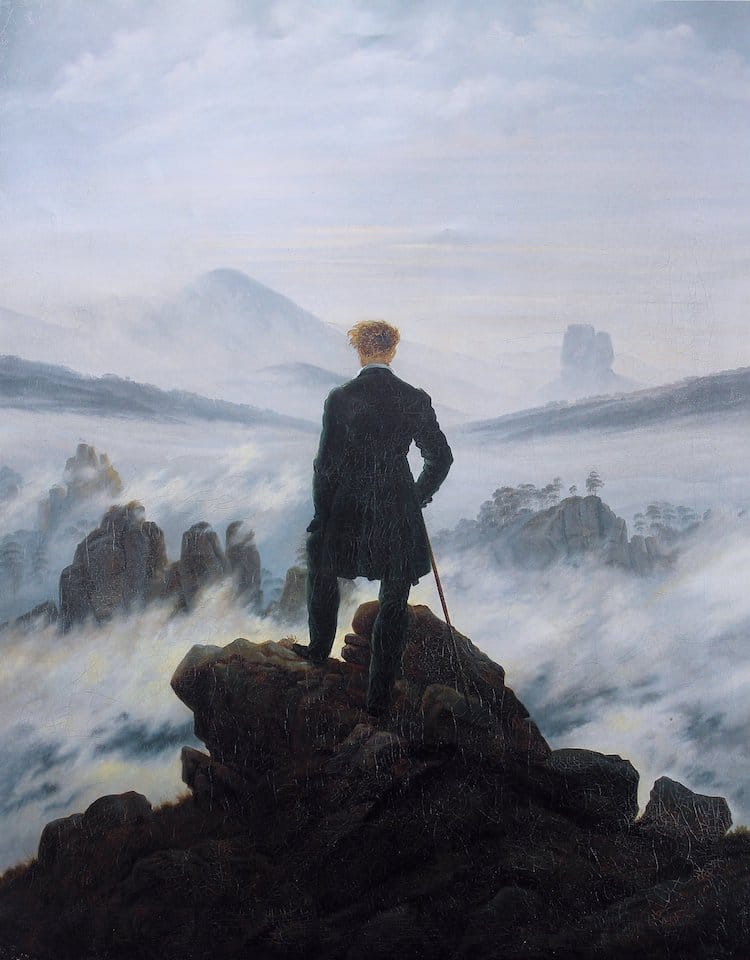
Caspar David Friedrich, “Wanderer Above the Sea of Fog,” c. 1817 (Photo: Hamburger Kunsthalle via Wikimedia Commons, Public domain)
A key work from German Romantic artist Caspar David Friedrich, Wanderer Above the Sea of Fog conveys the awe-inspiring and sublime characteristics of nature. Through the thick fog, jagged cliffs and rocky mountains topped with trees emerge in the distance. While a figure is featured in the center of the canvas, his back is to the viewer, redirecting his or her gaze to the backdrop.
John Constable, The Hay Wain, 1821
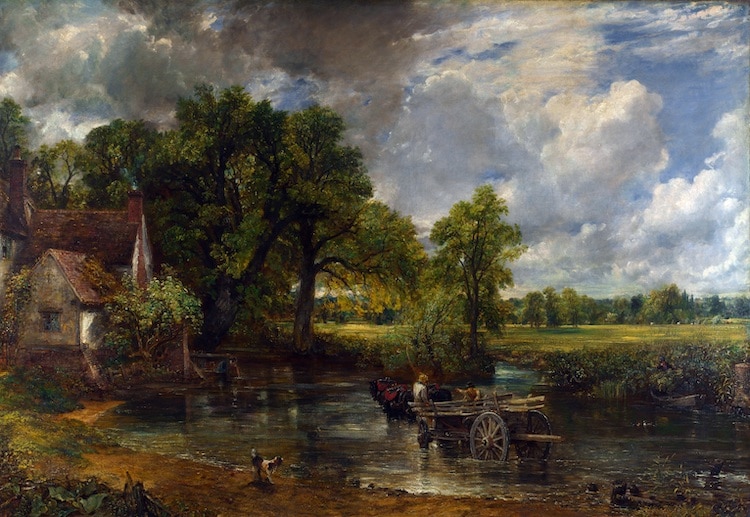
John Constable, “The Hay Wain,” 1821 (Photo: National Gallery via Wikimedia Commons, Public domain)
British painter John Constable rejected the highly idealized landscapes of the period and instead favored realistic depictions of the natural world. In his 1821 painting The Hay Wain, Constable depicts Flatford Mill, an area of land owned by his father, Golding Constable. Constable said of the landscape, “I associate ‘my careless boyhood’ with all that lies on the banks of the Stour; those scenes made me a painter.”
Thomas Cole, The Oxbow, 1836
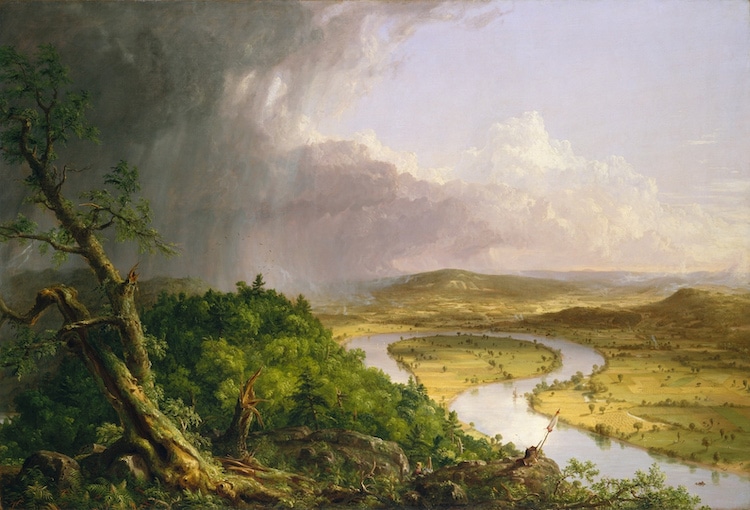
Thomas Cole, “View from Mount Holyoke, Northampton, Massachusetts, after a Thunderstorm—The Oxbow,” 1836 (Photo: The Met via Wikimedia Commons, Public domain)
British-American painter Thomas Cole is known for capturing the beauty of American landscapes and for founding the Hudson River School, a mid-19th century art movement led by a group of landscape painters who depicted the Hudson River Valley and the surrounding areas. The Oxbow features a sweeping view of the Connecticut River Valley, celebrating the expanse of the wilderness after a storm.
J. M. W. Turner, Rain, Steam and Speed – The Great Western Railway, 1844
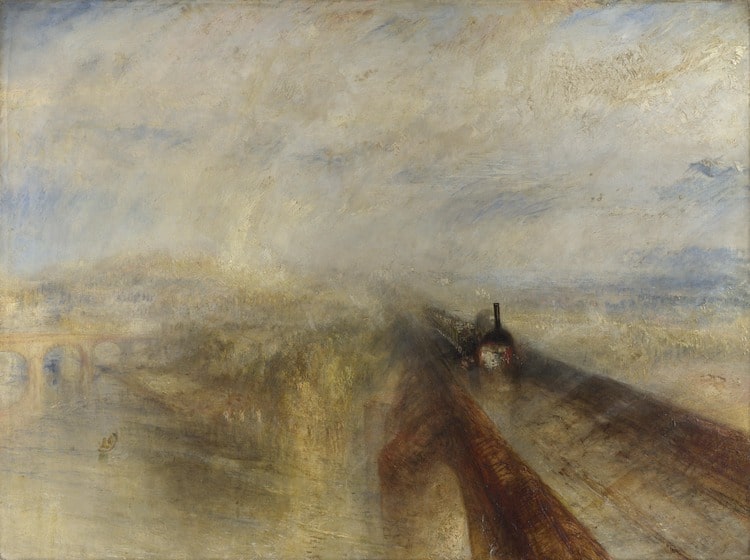
J.M.W. Turner, “Rain, Steam and Speed – The Great Western Railway,” 1844 (Photo: National Gallery via Wikimedia Commons, Public domain)
Living and working in 19th-century London, English artist J.M.W. Turner is known for his interest in powerful subject matter, as evident in both his sublime landscapes and studies of modern machinery. These two interests are synthesized in his painting Rain, Steam and Speed – The Great Western Railway, which portrays a train rushing through a murky landscape where the cloudy sky blends in with the architecture of the city on the horizon.
Albert Bierstadt, Looking Down Yosemite Valley, 1865

Albert Bierstadt, “Looking Down Yosemite Valley, California,” 1865 (Photo: Birmingham Museum of Art via Wikimedia Commons, Public domain)
Albert Bierstadt, who was of German origin, is among the second generation of great American artists. He is known for his large-scale paintings of the American West which showed many on the East Coast and in Europe what new areas of the United States looked like. His work, Looking Down Yosemite Valley, California captures a magnificent image of the untouched landscape.
Claude Monet, Impression, Sunrise, 1872
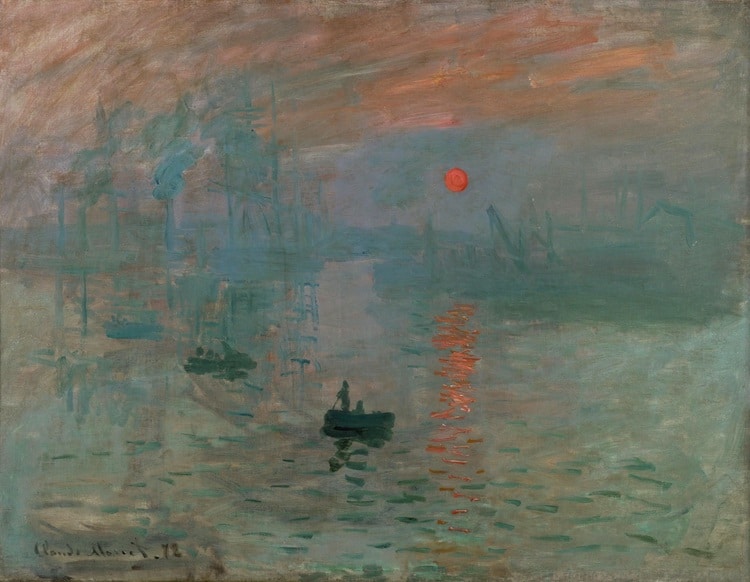
Claude Monet, “Impression, Sunrise,” 1872 (Photo: Musée Marmottan Monet via Wikimedia Commons, Public domain)
Impression, Sunrise depicts a hazy blue-hued seascape dotted with small boats and a bright orange sun. In fact, its radical use of expressive brushstrokes to portray a sunrise is what sparked the Impressionist art movement and named its creator, Claude Monet, the “Father of Impressionism.”
Paul Cézanne, Mont Sainte-Victoire, c. 1887
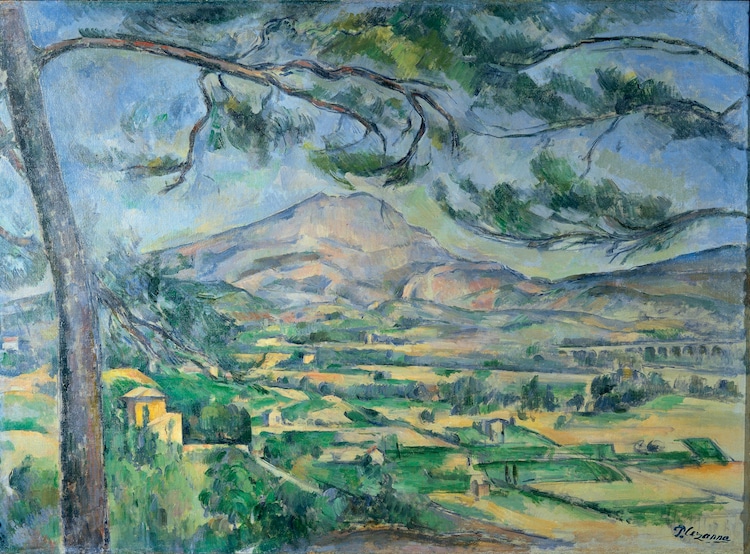
Paul Cézanne, “Mont Sainte-Victoire with Large Pine,” c. 1887 (Photo: Courtauld Institute of Art via Wikimedia Commons, Public domain)
Sainte-Victoire, a mountain in the South of France, remained Post-Impressionist painter Paul Cézanne‘s preferred subject matter for years. In his series of oil paintings portraying the landform, he experiments with different views, color palettes, and perspectives to produce a comprehensive look at the mountain and its surrounding landscape. In Mont Sainte-Victoire with Large Pine, he frames the scene with trees in the foreground and a village in the distance.
Vincent van Gogh, The Starry Night, 1889
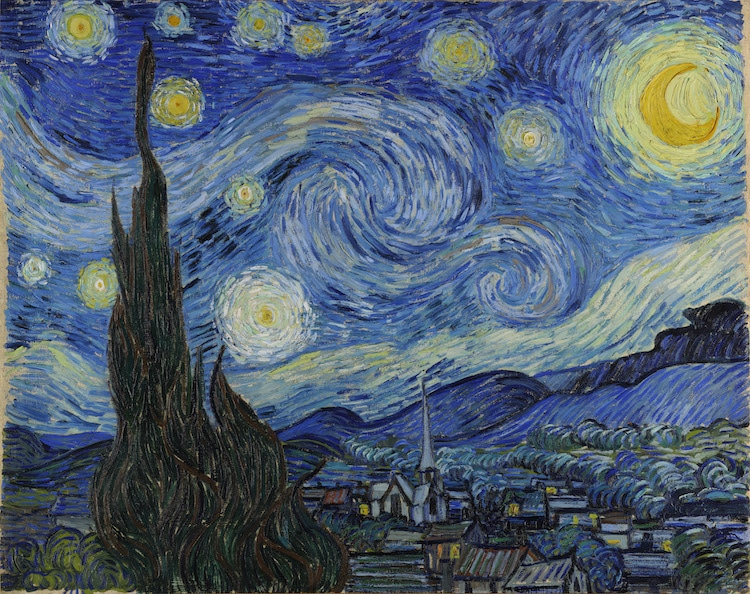
Vincent van Gogh, “The Starry Night,” 1889 (Photo: MoMA via Wikimedia Commons, Public domain)
While the Impressionist movement was preoccupied with portraying light in its painting, the Post-Impressionist movement focused on color. And few artists are as renowned for their use of color as Vincent van Gogh. The Starry Night was created late into the Dutch painter's short career and depicts the view from his window in the asylum at Saint-Rémy-de-Provence with wavy cypress trees silhouetted against a blue, swirling night sky lit up by a crescent moon and stars.
Andrew Wyeth, Christina's World, 1948
Artist Andrew Wyeth was one of the most famous American artists of the 20th century who is best remembered for working in a realist and regionalist style. His most beloved work, entitled Christina's World, depicts a woman with degenerative muscular disorder sprawled on the field, gazing yearningly towards the horizon dotted with small gray houses.
Related Articles:
9 Famous Renaissance Artists Whose Work Transformed the Art World
Here’s Where 20 of Art History’s Most Famous Masterpieces Are Located Right Now
Discover the 10 Most Expensive Paintings Ever Sold in the World
15 Famous Impressionist Paintings That Will Make You Fall in Love With the Style
